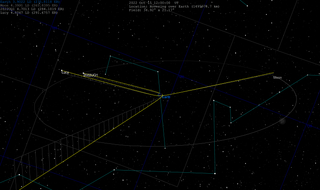2022 UQ1



2022 UQ1was aminor planet provisional designationthat was mistakenly given to theLucymission'sCentaur upper stage boosterduring its Earthgravity assistflybyin October 2022.[1]The object passed about 9,100 km (5,700 mi) from the center of Earth (or an altitude of 2,700 km (1,700 mi) above the surface of Earth)[a]during its closest approach on 16 October 2022.[2][3]
Because the object approached Earth from the direction of the Sun, it was not discovered until after its closest approach.[3]The object was discovered on 18 October 2022 by one of theAsteroid Terrestrial-impact Last Alert System(ATLAS) telescopes inRio Hurtado,Chile,which reported it to theMinor Planet Center(MPC) as anear-Earth objectcandidate.[1]Three other observatories produced follow-up observations on the following day and confirmed the object was on a near-Earth orbit, prompting the MPC to announce the object as a new near-Earth object with the provisional designation2022 UQ1on 19 October 2022.[1]The object was later identified as theLucymission's Centaur upper stage booster by Bill Gray and Davide Farnocchia, resulting in the MPC deleting2022 UQ1from its database on 20 October 2022.[4][5][6]
Orbit
[edit]
Lucy Centaur RB Booster·Sun·Earth·Venus·Mercury
| Date | ESA nominalgeocentric distance (AU) |
uncertainty region (1-sigma) |
|---|---|---|
| 2022-10-16 06:54 ± 00:17[b] | 0.0000609AU(9,100km)[a] | ±0.0000002 AU (30 km)[b] |
2022 UQ1came toperihelion(closest approach to the Sun) on 27 July 2022 at a distance of 0.84 AU, between the orbits ofVenusand Earth.[7]The Earth encounter in October reduced the period of its heliocentric orbit from 1 year to about 241 days and reduced its perihelion to 0.52 AU, placing it in between the orbits ofMercuryand Venus.[8]
| Parameter | Epoch | Period (p) |
Aphelion (Q) |
Perihelion (q) |
Semi-major axis (a) |
Inclination (i) |
Eccentricity (e) |
|---|---|---|---|---|---|---|---|
| Units | (days) | AU | (°) | ||||
| 2022-Oct-01 | 365.72 | 1.1630 | 0.83870 | 1.0008 | 0.1271° | 0.16201 | |
| 2022-Nov-01 | 241.23 | 0.9977 | 0.51906 | 0.7584 | 1.4283° | 0.31557 | |
See also
[edit]Notes
[edit]- ^abEarth centerpoint approach distance of9100 km–Earth radiusof6371 km=2729 kmfrom surface.
- ^abWhile theJPL Small-Body Databaseclose approach table lists more inclusive (and thus larger)3-sigmauncertainties, theEuropean Space Agencyclose approach table lists more common 1-sigma uncertainties.
References
[edit]- ^abc"MPEC 2022-U58: 2022 UQ1".Minor Planet Electronic Circular.Minor Planet Center. 19 October 2022.Retrieved20 October2022.
- ^ab"ESA Close Approaches: 2022UQ1".European Space Agency.Archived fromthe originalon 19 October 2022.Retrieved19 October2021.
- ^ab"JPL Small-Body Database Browser: (2022 UQ1)"(arc:1 day).Jet Propulsion Laboratory.Archived fromthe originalon 19 October 2022.Retrieved19 October2021.
- ^"MPEC 2022-U79: Deletion of 2022 UQ1".Minor Planet Electronic Circular.Minor Planet Center. 20 October 2022.Retrieved20 October2022.
- ^Gray, Bill J. (20 October 2022).""Pseudo-MPEC" for Lucy Centaur ".Project Pluto.Retrieved20 October2022.
- ^Gray, Bill J. (19 October 2022)."Re: 2022 UQ1 related to Lucy?".Minor Planet Mailing List.Retrieved19 October2022.
It's definitely the Lucy Centaur.
- ^Horizonsoutput."Perihelion on 2022-Jul-27"(Perihelion occurs when rdot flips from negative to positive). Archived fromthe originalon 20 October 2022.Retrieved20 October2022.
- ^abHorizonsoutput."Osculating Orbital Elements for 2022 UQ1 at Oct + Nov 2022".Archived fromthe originalon 19 October 2022.Retrieved19 October2022.
External links
[edit]- Lucy rocket booster trajectory(Tony Dunn)
- Closest Asteroid Flyby in 2022 Was Really Space Junk From NASA Missioncnet.com, Oct 20, 2022
- Asteroid (NEO) 2022 UQ1
- 2022 UQ1atNeoDyS-2, Near Earth Objects—Dynamic Site
- 2022 UQ1at theJPL Small-Body Database


